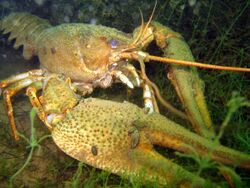Biology:Astacus leptodactylus
| Astacus leptodactylus | |
|---|---|

| |
| Scientific classification | |
| Domain: | Eukaryota |
| Kingdom: | Animalia |
| Phylum: | Arthropoda |
| Class: | Malacostraca |
| Order: | Decapoda |
| Suborder: | Pleocyemata |
| Family: | Astacidae |
| Genus: | Astacus |
| Species: | A. leptodactylus
|
| Binomial name | |
| Astacus leptodactylus Eschscholtz, 1823
| |
Astacus leptodactylus, the Danube crayfish,[1] Galician crayfish,[1] Turkish crayfish[2] or narrow-clawed crayfish is a species of brackish water crayfish imported and introduced to Central Europe in 19th century from the Caspian Sea region.[2]
Description
Astacus leptodactylus can grow up to 30 centimetres (12 in) in length from the tip of the rostrum to the end of the telson (tail), but is more commonly found at around 15 cm (6 in) in length. The sides of the thorax are very rough, usually pale yellow to pale green in colour. A. leptodactylus has two pairs of post-orbital ridges, the second of which may have spines. It also has a prominent tubercle (small nodule) on shoulder of the carapace. The claws of Astacus leptodactylus are long and narrow (hence the common name 'narrow-clawed crayfish'). Their upper surface is rough and the underside is the same colour as the body. A tubercle can be found on the fixed side of the claw. A. leptodactylus can be distinguished most easily from the European or broad-fingered crayfish, Astacus astacus, by the relatively thinner "fingers" of the claws. Further studies done on the Astacus leptodactylus found that they can be co-infected by two or more different pathogens. A study done by R. Salighehzadeh saw that after collecting 10 narrow-clawed crayfish found that they contained 2 pathogenic isolates simultaneously, the Aeromonas hydrophilia and Fusarium solani.[3]
Ecology
Astacus leptodactylus is fairly docile, especially the male with large claws, and favours relatively still brackish waters such as lakes and canals. It is listed as a species of Least Concern on the IUCN Red List.[4]
References
- ↑ 1.0 1.1 James W. Fetzner Jr. (January 14, 2008). "Astacus leptodactylus (Eschscholtz, 1823): Danube crayfish, Galician Crayfish". Crayfish Taxon Browser. Carnegie Museum of Natural History. https://www.ncbi.nlm.nih.gov/Taxonomy/Browser/wwwtax.cgi.
- ↑ 2.0 2.1 "Astacus leptodactylus – Turkish Crayfish". UK non-native organism risk assessment scheme version 3.3. DEFRA. https://secure.fera.defra.gov.uk/nonnativespecies/downloadDocument.cfm?id=234.
- ↑ Salighehzadeh, Reza; Sharifiyazdi, Hassan; Akhlaghi, Mostafa; Khalafian, M.; Gholamhosseini, Amin; Soltanian, S. (31 December 2018). "Molecular and clinical evidence of Aeromonas hydrophila and Fusarium solani co-infection in narrow-clawed crayfish Astacus leptodactylus". Diseases of Aquatic Organisms 132 (2): 135–141. doi:10.3354/dao03309. ISSN 0177-5103. https://www.researchgate.net/publication/328532790_Molecular_and_clinical_evidence_of_Aeromonas_hydrophila_and_Fusarium_solani_co-infection_in_narrow-clawed_crayfish_Astacus_leptodactylus.
- ↑ F. Gherardi; C. Souty-Grosset (2017). "Pontastacus leptodactylus". IUCN Red List of Threatened Species 2017: e.T153745A120103207. doi:10.2305/IUCN.UK.2017-3.RLTS.T153745A120103207.en. https://www.iucnredlist.org/species/153745/120103207.
External links
Wikidata ☰ Q571290 entry


